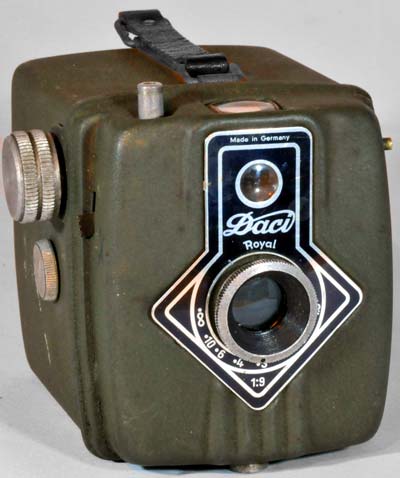Dacora Daci Royal Flash
Specification

| Manufacturer | : | Dacora |
|---|---|---|
| Produced | : | 1951 |
| Classification | : | Medium Format |
| Body Type | : | Box |
| Construction | : | Metal |
| Film Type | : | 120 |
| Film Width | : | 62mm |
| Image Size | : | 2¼ x 2¼ in |
| No. of Images | : | 12 |
| Lens Type | : | meniscus |
| Focal Length | : | 95mm |
| Focus Type | : | variable |
| Focal Range | : | 1.5m-inf. |
| Aperture Type | : | Fixed |
| Apertures | : | f/9 |
| Shutter Type | : | Rotary |
| Shutter Speeds | : | B, I*(1/100s) |
| Size (w x h x d) | : | 90 x 90 x 105 mm |
| Weight | : | 372g |
| * Measured on this camera | ||
Art Deco Credentials
![]()
![]()
Acceptable: Modest and restricted
- Produced after the main Art Deco period
- Art Deco Streamline Moderne design
- Pressed steel body with rounded corners
- Geometric multiline ribs on front
- Symmetrical layout to front
Description
Daci Royal Flash is a medium format box camera made by Dacora and introduced in 1951. Its lens was superior to that of the preceding Bakelite Daco because it was focusable from 1.5m to infinity. It was sold in several colours of red, black, gray and dark green. There was also a non-flash version produced in 1950. The non-flash Dacora Daci Royal had a slightly different layout of controls with the release lever being on the side. It uses 120 rollfilm producing 12 images with picture size 6x6cm.
It has a quite small built-in reflecting type viewfinder. Its rotary shutter is switchable from instant mode to bulb mode using a lever on the side. The shutter release is on the top which is threaded for use with a remote release cable. It has an aperture of f/9 and it can be focussed down to 1.5m by turning the lens mount.
Film is loaded by turning a knob on the right hand side of the camera which releases the back of the camera. The flash sync socket is on left side of body. There is a single tripod mount socket on the base of the camera.
How to Use
This camera takes 120 film which is widely available. It is advisable to cover the red window except when winding film in low light.
The aperture is f/9. The measured speed on this camera was 1/100s. As the shutter speed is only 1/100s, it is advisable to use a tripod or hold it against a wall or other solid object to get shake-free images. For quick snapshots, hold it firmly against your body.
The table shows how this camera will perform using ISO 100/125 film. It is based on the 'Sunny 16' rule. Modern film is so forgiving and will produce acceptable results even when overexposed by 2 or 3 stops or underexposed by 1 stop.
The tables assume that the sun is at least 30 degrees above the horizon - that's 10am - 5pm on a summers day (May-August) in the UK.
Remember that the exposure guide in the manual may not be helpful as it is based on the use of old film with a low ISO value.
Using ISO 100/125 film - shutter speed 1/100s
| Weather Conditions | Shadow Detail | Aperture | Exposure |
|---|---|---|---|
 Sunny SunnySnow/Sand | Dark with sharp edges | f/9 | 3 Stops Overexposed Acceptable |
 Sunny Sunny | Distinct | f/9 | 2 Stops Overexposed Acceptable |
 Slight Overcast Slight Overcast | Soft around edges | f/9 | 1 Stop Overexposed Acceptable |
 Overcast Overcast | Barely visible | f/9 | Good |
 Heavy Overcast Heavy Overcast | None | f/9 | -1 Stop Underexposed Acceptable |
 Open Shade Open Shade/Sunset | None | f/9 | -2 Stops Underexposed Not Acceptable |